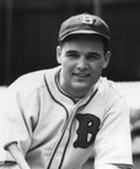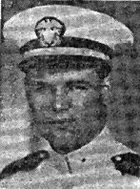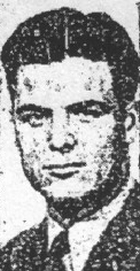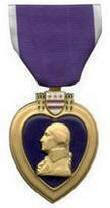Stan Klores
| Date and Place of Birth: | May 3, 1916 Milwaukee, WI |
| Date and Place of Death: | December 3, 1944 Ormoc Bay, Leyte, Philippines |
| Baseball Experience: | Minor League |
| Position: | First Base/Outfield |
| Rank: | Lieutenant (jg) |
| Military Unit: | US Navy |
| Area Served: | Pacific Theater of Operations |
If he continues his hustling and hits and fields as well as
he has in the first few games this season, Stan won’t be around
Bloomington very long. He seems destined for the majors.
Bloomington Sunday Pantagraph May 15, 1938
Stanley P. Klores was born in Milwaukee, Wisconsin, and grew up in
West Allis, a suburb of the city. While he was a youngster in the 1920s,
there was no youth baseball in West Allis, so the resourceful Klores set
about organizing his own team. With the help of a local playground
director, Klores established a six-team league. He was with the 52nd
Street All-Stars. “None of the kids had any dough,” he recalled some
years later, “so when we were asked to put up a five dollar forfeit fee,
I had to kick in with $4.17 of it. The other eight on the team scraped
up 83 cents between them. When the league was abandoned because of a
lack of balls for the games, I lost my dough. Boy, that was
heartbreaking!”
Klores attended West Allis High School where he starred on the varsity
baseball team, and in 1934 he played with the Holy Assumption CYO team
that won its section championship and went to the national playoffs at
Wrigley Field, Chicago. In the final game, Klores hit a single, double
and triple to help Holy Assumption win. That performance drew the
attention of Cubs vice president John Seys. Klores wrestled with the
idea of a career in professional baseball but chose instead to enroll at
Northwestern University at Evanston, Illinois, in the fall of 1934. He
quickly made his mark on the athletic field at Northwestern and was
ranked as the best end on the freshman football team. Furthermore, he
was a certainty to play first base the following spring, but the Chicago
Cubs were still interested, and when he realized he could play baseball
in the summer and study during the fall and winter, he signed his first
professional baseball contract. Together with University of Wisconsin
pitcher Carl Vaicek, Klores joined the Cubs at Catalina Island,
California, for spring
training in 1935. The two youngsters trained
there with Stan Hack, Kiki Cuyler, Chuck Klein and Phil Cavarretta.
For the 1935 season, Klores was assigned to the Peoria Tractors of the
Class B Three-I League. The smooth left-handed hitting outfielder played
114 games for the Tractors and batted a highly respectable .283 with six
home runs and 48 RBIs. The following year he began the season playing
first base with the Portsmouth Cubs of the Class B Piedmont League,
before joining the Asheville Tourists of the same league. In June of
that same year—after 42 games in the Piedmont League that saw him
batting .278—Klores was on the move again, joining the Huntington Red
Birds of the Class C Mid-Atlantic League. He played 15 games with the
Red Birds before moving to the Martinsville Manufacturers of the Class D
Bi-State League, where he batted .330 in 66 games.
In 1937, Stan Klores joined the Montgomery Bombers of the Class B
Southeastern League and hit .276, with a team-leading 69 RBIs. The
Milwaukee Brewers of the American Association claimed the first baseman
at the end of the season and assigned him to the Bloomington Bloomers of
the Three-I League, the same league where he had begun his professional
career in 1935. His season got off to a good start. “If he continues his
hustling and hits and fields as well as he has in the first few games
this season,” announced the Bloomington Sunday Pantagraph, “Stan won’t
be around Bloomington very long. He seems destined for the majors.” His
peppy chatter and congenial spirit made Klores a fan favorite in
Illinois, but a mid-season leg injury seriously hampered his play and as
his batting average began to slip, so did his hopes of reaching the
major leagues. Klores ended the 1938 season batting .231 over 97 games.
It was the worst of his four years in the minors and caused the
22-year-old to consider opportunities outside of baseball.
Wisely, Klores had not neglected his education and had continued his
studies at Northwestern’s College of Liberal Arts each fall semester. At
this point he was quite far along toward a college degree and chose to
pursue that route. The decision, however, did not spell the end of his
relationship with baseball. Klores spent the summer of 1939 batting
cleanup for the Chicago Spencer Coals, pennant winners of the semi-pro
Tri-State League. Then, in February 1940, Northwestern University’s
athletic director, K. L. “Tug” Wilson, announced that Klores would take
over duties as the Wildcats’ head baseball coach, succeeding Burt
Ingwersen, also an assistant football coach, who had decided to
concentrate on spring practice in that sport.
For many years, Northwestern had been the smallest and the only private
school in the Big Ten Conference, and the baseball team had endured a
mixed record. They had never finished better than third and had finished
in fourth place winning seven out of 12 games in 1939. Klores brought
new promise to the team. He inherited one of the largest squads to
report for baseball in March 1940, when 33 players, including 10 varsity
athletes, tried out for 18 places that were available for an eight-game
preseason trip to Alabama and Louisiana. Klores firmly believed in
developing his players’ fundamentals and felt there was no room at the
college level for fancy plays and showboating. “All that I ask of a
player is that he possesses a fairly good arm, speed on the bases and
fair judgment,” he explained. “If he is ambitious to make a career of
baseball he should master the fundamentals in college and leave the
tricky stuff until he gets in the minors.” Encouraged by his squad’s
early showing, Klores must have been surprised to see the Wildcats get
off to an inauspicious start in conference play, losing two games to
Illinois. But then the team settled down to win two games each from
Chicago, Minnesota, Iowa and Wisconsin. In the final series with Ohio
State University, the Wildcats lost the first game, 3–2, but rallied to
win the second game, 6–5. This gave Northwestern a record of nine
victories against three losses and a tie for the Big Ten championship
with Illinois. Five players from the 1940 Wildcats went on to play in
the minor leagues.
Klores earned his bachelor of science degree in June 1940, and was back
with the Chicago Spencer Coals during the summer. He returned to coach
Northwestern in 1941, but the loss of five regulars from the previous
year’s championship team proved too big a handicap for the Wildcats. The
team dropped to fourth place in the Big Ten conference with five wins
against six defeats. “During my freshman year at Northwestern,” recalled
John Eshbach, “I was invited to become freshman baseball manager and
during the spring of 1941 I got to know Stan. Everyone had great respect
for him—as an outstanding athlete, a bright, congenial person, and
all-round good man.”
Klores received his master’s degree at the beginning of June 1941. Then
on June 7 he enlisted in the U.S. Naval Reserve and, soon after,
enrolled at Northwestern’s Midshipman’s Naval Training School. It was
during this time that the Japanese launched their attack on Pearl
Harbor. With the nation thrust into war, Ensign Klores was among 800 who
graduated from midshipman’s school at the beginning of January 1942.
Shortly afterwards he married his college sweetheart, Martha Whitehouse
(May Queen of 1940, student leader of Northwestern’s Women’s Athletic
Association, and daughter of a music faculty professor) and the couple
left for Annapolis, Maryland, where Klores took a fivemonth special
training course in naval communications.
In October 1942, Klores received his first active duty assignment as a
communications officer with the newly built 2,100-ton destroyer USS
Conway (DD-507). The Conway cleared Norfolk, Virginia, on December 5,
1942, bound for New Caledonia in the Pacific, arriving there on January
13, 1943. Later that month, she was part of a force that met Japanese
ships evacuating troops from Guadalcanal. Throughout February 1943, she
patrolled between Espiritu Santo and Guadalcanal, and it was around this
time Klores received word from the Red Cross that Martha had given birth
to a son, Stanley Whitehouse Klores, on December 5, 1942. The family had
sought without success for six weeks to make contact with Klores.
Finally, his wife appealed to the Red Cross. It took them just five days
to let him know the good news.
On March 4, the Conway participated in the bombardment of Vila-Stanmore
in the Solomon Islands, and on March 15, she sailed in support of the
Rendova Island landings, escorting supply ships before becoming involved
in the New Georgia operations. Life on a destroyer in the Pacific, so
far away from family, was a difficult time. “The innings are too long in
this ball game,” wrote Klores in a melancholy letter to Northwestern on
May 12, “and we haven’t even started to bat.” In another letter received
in June 1943, Klores revealed his feelings of uncertainty about his
situation while reflecting on the deaths in battle he had witnessed:
“You seldom get an icky feeling, because so much activity and work keeps
your mind from thinking of it. However, now and then a cloud of
sentimentalism does center over your head, and you wonder what the
future holds in store. You never do forget that the other guys were made
of the same flesh as yours.”
Between July and August, the Conway operated out of Purvis Bay in the
Solomon Islands, escorting fueling units and making night raids on
Japanese shipping. Later in the month, she was back at Guadalcanal,
conducting night raids on Japanese barges. The Conway sailed to Sydney,
Australia, for overhaul in October 1943, and after a year at sea, Klores
returned to the United States and was reunited with Martha and their
newborn son.
In November 1943, Klores made the somewhat unusual request for transfer
to flight duty with the Navy Air Corps. Why he chose to train as a pilot
is not certain, but he certainly welcomed the prospect of remaining in
the states for the period needed for training, allowing more time to be
with his family. He attended an 11-week pilot training course as a
student officer at Dallas Naval Air Station, Texas. But experienced
naval communications officers were harder to come by than aviation
cadets and he soon found himself assigned to another brand new
destroyer, the 2,200 ton USS Cooper (DD-695). At the time, it seemed a
fortunate move as his brother-in-law Robert Whitehouse had earlier lost
his life in a plane crash while training with the Army Air Corps.
“I last saw Stan in April 1944,” said Eshbach, the freshman baseball
manager from Northwestern, who had become engaged to Martha’s sister
Barbara in early 1944. “He had invited us to have dinner with him on the
Cooper at the Brooklyn Navy Yard.” By the time Eshbach and Barbara
married on August 1, 1944 (making Eshbach, Klores’
brother-in-law), the Cooper was at sea, arriving at Pearl Harbor on
September 4. After operational training, she proceeded to the active war
zone in the western Pacific and joined the action. The Cooper screened
aircraft carriers involved in air attacks on Luzon, Ormoc Bay, and
Manila Bay in the Philippines, and participated in patrols in Leyte Gulf
until December 2.
It was during this time that General MacArthur led the Allied forces on
their return to the Philippines, marked by the landing, on October 20,
1944, at Tacloban on the east coast of the island of Leyte. The
Japanese, however, maintained a strong position on Leyte’s west coast
and were re-supplying their troops through Ormoc Bay. During the night
of December 2–3, the Cooper, along with two other destroyers, sailed
into Ormoc Bay to intercept Japanese shipping. An engagement with
Japanese warships ensued and, just after midnight, the Japanese
destroyer Take launched her torpedoes at the Cooper, which suffered a
massive explosion on her starboard side, broke in two, and sank almost
immediately. Klores, who ordinarily was stationed on the bridge, was on
duty in the Combat Information Center at the time. The Cooper had just
disposed of one enemy vessel and had trained its guns on another when
she was hit. Every man in the Combat Information Center perished.
Japanese ships in the area prevented rescue of survivors for 14 hours,
but eventually 168 crew members were saved. Klores was among the 191
that were lost.
“My ship, the USS Rooks, sailed to Pearl Harbor early in December 1944,”
recalled Eshbach. “As soon as I was able, I went to the destroyer
headquarters to inquire about the location of the Cooper, hoping that
it, with Stan, might still be in the area. It was a very severe shock to
learn that the Cooper had been torpedoed just a few days earlier. We had
been brothers-in-law for just four months and had not seen each other
during that time.”
It was three weeks after the Cooper sank, on December 26, 1944, that
Martha Klores received word from the Navy Department that her husband
was missing in action. The family held out a faint glimmer of hope for
his safe return until January 10, 1945, when a telegram officially
listed him as killed in action. Klores’ body was never recovered. He is
remembered at the Manila American Cemetery in the Philippines.
On April 7, 1945, four months after Stan’s death, Martha gave birth to
Judith Klores, their daughter. Stan, of course, had been aware that
their second child was on the way, but he would not see her. Their son,
Stanley, graduated from Northwestern, like his parents, and today the
Rev. Stanley Klores is the Pastor at St. Patrick’s Church in New
Orleans, Louisiana. He was just two years old when his father was
killed. “I have no first-hand memories of him,” The Reverend Klores
recalled. “However, everything that I have ever heard or read about him
has described him as a fine man, a man of character and virtue, a
natural leader.”
|
Team |
League |
Class |
G |
AB |
R |
H |
2B |
3B |
HR |
RBI |
AVG |
|
| 1935 | Peoria | Three-I | B | 114 | 420 | 52 | 119 | 22 | 6 | 6 | 48 | .283 |
| 1936 |
Portsmouth /Asheville |
Piedmont | B | 42 | 144 | 18 | 40 | 7 | 2 | 0 | 29 | .278 |
| 1936 | Huntington | Mid-Atlantic | C | 15 | 52 | 7 | 14 | 4 | 0 | 1 | 7 | .269 |
| 1936 | Martinsville | Bi-State | D | 66 | 261 | 39 | 86 | 17 | 4 | 6 | 49 | .330 |
| 1937 | Montgomery | Southeastern | B | 132 | 526 | 74 | 145 | 18 | 11 | 3 | 669 | .276 |
| 1938 | Bloomington | Three-I | B | 97 | 333 | 43 | 77 | 14 | 8 | 2 | 42 | .231 |
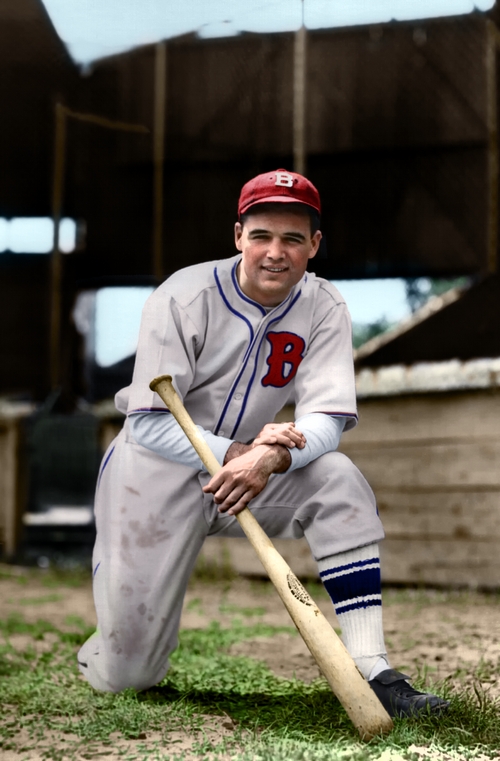
Stan Klores with the Bloomington Bloomers of the
Three-I League
(This beautiful colorized image of Stan Klores was created by Chris
Whitehouse. You can see more of his work at
http://procamsportsphotos.photoshelter.com/gallery/MANCAVE-VINATGE-PRINTS-FOR-SALE/G0000c3lAJjhq_qE/C0000zEsx9oATTdU)
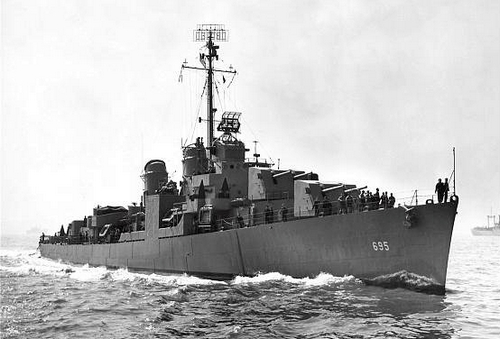
USS Cooper (DD-695)
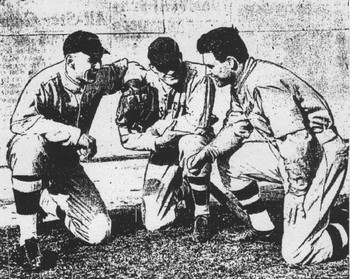
Stan Klores (far right) talks to Northwestern pitchers
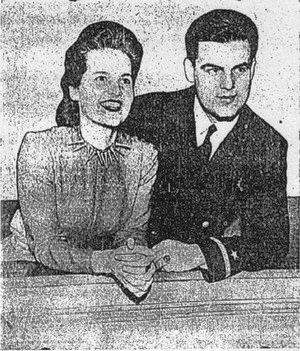
Martha and Stan Klores
Special thanks to Amy Richard at the Bloomington Public Library for taking the time to research and reproduce countless articles from the Bloomington Pantagraph. Thanks to Kevin B. Leonard, University Archives at the Northwestern University Library for superb background information on Stan Klores’ time at Northwestern. And special thank yous to John Eshbach and to Reverend Stanley P. Klores for giving me his blessing in compiling this biography of his father.
Date Added February 1, 2012 Updated July 30, 2017
Baseball's Greatest Sacrifice is associated with Baseball Almanac
Baseball's Greatest Sacrifice is proud to be sponsored by

